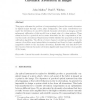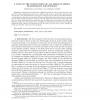82 search results - page 2 / 17 » Two Results on Real Zeros of Chromatic Polynomials |
PRL
2007
13 years 5 months ago
2007
This paper addresses the problem of compensating for lateral chromatic aberration in digital images through colour plane realignment. Two main contributions are made: the derivati...
SIAMNUM
2010
13 years 11 days ago
2010
Polynomials with quaternionic coefficients located on only one side of the powers (we call them simple polynomials) may have two different types of zeros: isolated and spherical ze...
DM
2007
13 years 5 months ago
2007
We show that each polynomial a(z)=1+a1z+· · ·+adzd in N[z] having only real zeros is the f-polynomial of a multicomplex. It follows that a(z) is also the h-polynomial of a Cohe...
JC
2008
13 years 5 months ago
2008
We describe an algorithm to count the number of distinct real zeros of a polynomial (square) system f. The algorithm performs O(log(nD(f))) iterations (grid refinements) where n is...
EUROCRYPT
1999
Springer
13 years 10 months ago
1999
Springer
Abstract. We present the first efficient statistical zero-knowledge protocols to prove statements such as: – A committed number is a prime. – A committed (or revealed) number ...


